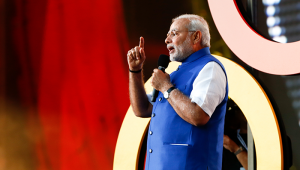Governments have taken on unprecedented levels of peacetime borrowing to deal with the crisis caused by Covid-19. But public debt has been on the rise for years. With economies and populations around the world in desperate need of succour from the public sector, there is heightened interest in an economic theory that, according to supporters, suggests there is no direct consequence of the runaway government borrowing.
Modern monetary theory proponents say that governments issuing their own currency can never go bankrupt – as long as that currency floats, and as long as they are the only government that issues it (unlike eurozone countries, for instance). Therefore, MMT advocates claim that revenue has no bearing on a government’s ability to spend. Does the huge amount of borrowing currently being undertaken by governments mean the world is conducting a massive experiment in MMT?
The theory originated in the early 1990s, but picked up momentum after the global financial crisis as people looked for new ways of thinking about the economy. In the past few years, MMT has received publicity from the likes of US politician Alexandria Ocasio-Cortez, who said it should “be a larger part of our conversation” about the economy.
“The government spends by changing numbers up, and taxes by changing them down,” says Warren Mosler, who is widely credited with originating MMT. “It is like scoring a field goal in American football, and wondering where they got the three points from. It’s just record-keeping.”
The ‘money story’ of MMT, Mosler explains, is this: the government of, say, the US wants to provide itself with a military force, education, public healthcare and so on, so it creates the dollar. To get people to accept the dollar, it then requires taxes to be paid in dollars, which forces people to take on work or sell goods in exchange for – otherwise worthless – dollars.
“We should recognise that if MMT theorists are guilty of anything, it is of understating the costs of taking on huge debts” - George Selgin, Cato Institute
The government is then able to hire people and pay them with dollars, and because it and its agents, such as the central bank, are the only primary source of dollars, people will work for them as soldiers, teachers, nurses and so on. Dollars then circulate in the economy, allowing public sector workers to buy food and other items that people sell in order to get dollars. The dollars are then passed around the economy until eventually ending up as taxes paid back to the government, when they cease to exist.
“If you pay your taxes with actual cash, the government gives you a receipt, takes the bills and sends them off to be shredded,” says Mosler. “That is the end of the chain. That is why it is called a ‘tax return’; that is why we call it ‘revenue’ [which came to English from Latin through French and means ‘return’]; that is why in the Bible it says ‘Render to Caesar the things that are Caesar’s’. The bills themselves do not have any value.”
Because a government with a fiat currency can never go bankrupt and does not rely on taxation for income (it can be used instead to fight inflation, redistribute income or discourage harmful activities), ideas of debt sustainability are irrelevant, the theory says. “Debt doesn’t give you a guide for policy,” says Mosler, “There is no reason to even publish debt figures.”
Change the lens
Once you look through the MMT ‘lens’, as its subscribers think of it, deficits are simply money in the economy that has not yet been (but ultimately will be) collected in tax, so policies do not need to be designed with the aim of reducing those deficits. Whereas orthodox economics sees deficits as increasing the demand for borrowing, thereby driving up interest rates, MMT claims that the state can set interest rates at zero, or even pay off debts immediately by changing some numbers on a computer. Therefore, other concerns, such as fighting climate change, eradicating poverty or responding to the pandemic, can inform spending choices.
“Governments should not be obsessed by deficits,” says Dr Martin Watts, professor of economics at the University of Newcastle in Australia. “They should work out their budgetary strategy on the basis of achieving full employment, or for another public purpose. Outcomes are what is important.”
Some more cavalier advocates of MMT, particularly online, claim this means governments can spend without consequence by ‘printing money’ – an idea Watts wants to dispel. “MMT gets criticised because there is an assumption we are saying the government can always spend huge amounts, but we are not saying that,” he explains. “We are saying there is not a financial constraint.
“For instance, there is no financial constraint on the government deciding to deposit £1,000 in everyone’s bank account. It is not printing money; it is some clicks on the computer. You might think that sounds highly irresponsible, and it might well be
for any number of reasons.”
Spending constraints
Constraints on spending, both Mosler and Watts suggest, could include scarcity of resources or the eventual unavailability of labour as the economy nears full employment. Hyperinflation, which orthodox economists would expect with large amounts of money creation, would only happen at full employment, and could then be controlled by increasing taxes to reduce aggregate demand.
Many other economists are sceptical about the theory. “At the core of MMT is a truth that the government can finance what it is doing by a range of sources, including borrowing, but the challenge is it tends to think there are no further consequences of doing that, other than inflation,” says James Meadway, associate fellow at progressive think-tank IPPR’s Centre for Economic Justice and former adviser to previous shadow chancellor John McDonnell.
“The idea that governments can try to use taxes to regulate inflation is such a non-starter, because of politics. A government could not see prices rising and then say it is going to raise taxes too.”
Meadway says there are resource implications when governments create money, shown by the inequalities created by quantitative easing since the global financial crisis. Cheap money was available to the wealthy and the stock market soared, while wages stagnated.
Since the beginning of the pandemic, central banks have been buying up government borrowing even faster than they did just over a decade ago. “Central banks buying debt used to be very different from the private sector buying it, but it is not so different now,” says George Selgin, senior fellow and director of the Cato Institute’s Center for Monetary and Financial Alternatives.
“Before 2008, the Federal Reserve did not pay any interest on reserves that banks held, and it backed those with government bonds. Most of the interest, after covering the Fed’s expenses, was rebated to the Treasury. Essentially, the Treasury was borrowing interest-free. But, since 2008, the Fed has paid interest on bank reserves, which means the interest the Treasury is paying on its debt goes instead to banks. People claim that when the Fed is financing [Covid-19] aid programmes, we are getting a bargain, but these days it is not a bargain at all.”
So how does the current global crisis relate to MMT? Watts says that with reduced employment and income meaning lower tax receipts – even without considering increased spending needs – there is an “inevitability of higher fiscal deficits for some years to come”. But an assessment of the outcomes, relating to MMT, cannot take place in the near future, because these are long-run processes.
“There are, however, past precedents,” he suggests. “Western governments have not been reluctant to involve themselves in wars – quite often in faraway places. The attitude has been ‘we will do what it takes’, so spending has been based on strategic needs and not contentious economic arguments. Political attitudes towards the pandemic have been similar.”
Selgin says applying MMT to pandemic spending is simply a question of scale – MMT supporters believe governments could safely spend a lot more than they are. “They might be right up to a point, but where is that point? The question really boils down to what the limits are, and it is not just about whether governments can default. I think we can all agree that a government that issues its own currency never has to default.”
Selgin warned that the level of spending often proposed by MMT advocates could result in high inflation or the need to raise taxes or interest rates exorbitantly, meaning the public will have to make do with less in order for the government to pay its bills. “There is no free lunch out there,” he says.
Growing influence?
MMT has had nothing to do with US government thinking, Selgin adds, as the response so far has been undertaken by a Republican government. Current enthusiasm for MMT in the US exists mainly on the left wing, from supporters of Ocasio-Cortez or former presidential hopeful Bernie Sanders. “Under the Biden administration, I think we will see some more influence of MMT, seeking to further government spending,” he says. “This is not necessarily a disaster, but we should recognise that if MMT theorists are guilty of anything, it is of understating the costs of taking on huge debts.”
Orthodox economists say ever-increasing debt would eventually lead to high interest rates and expensive payments. “There would have to be some point where that happens,” argues Scott Sumner, chair of monetary policy at the Mercatus Center at George Mason University in Virginia, US. “I believe MMT suggests you could set interest rates at zero, and, with them so low around the world already, it doesn’t seem so strange to a lot of people.”
But ‘taking advantage’ of low interest rates by increasing the debt would still have costs in the future, potentially from high interest rates. Although Sumner agrees with running large deficits during the pandemic, he warns that future challenges remain in place, such as ageing populations in many developed economies.
“Even if it were true that there is a free lunch for now, that would be likely to change in the future,” he says. “The way we should look at it is to hope to make that crisis less severe by not running massive deficits [as a matter of course].”
Sumner says the main risk in the future, if spending now continues unabated, is much higher taxes. “The optimal policy from a tax perspective would be to not run large deficits now, and then we would like smooth tax rises over a long period of time.”
Under MMT, of course, that is not true. Perhaps the fallout from Covid-19 will lend credence to the framework, but any evidence will take years to emerge. The disagreements around MMT concern the fundamental nature of money, and it is going to take more than a pandemic and the biggest recession in a lifetime to sort that out.














